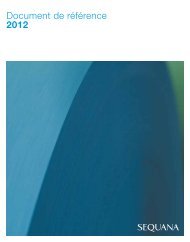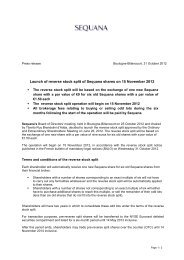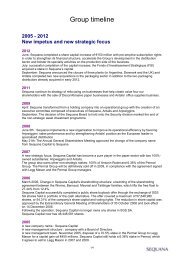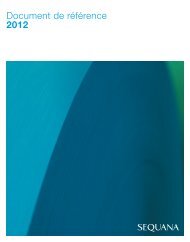Contents
Registration document PDF - Sequana
Registration document PDF - Sequana
Create successful ePaper yourself
Turn your PDF publications into a flip-book with our unique Google optimized e-Paper software.
4Financial position – resultsNotes to the consolidated financial statements■■the portion of the levy based on companies’ “value added” (cotisationsur la valeur ajoutée des entreprises – CVAE) is recognisedas income tax because the amount of the value added is net ofincome and expenses and complies with the definition of anincome tax provided in IAS 12.2.B27 - Earnings per shareBasic undiluted earnings per share are calculated by dividing netincome attributable to owners by the average number of sharesoutstanding during the year, excluding treasury shares (calculatedon a monthly average basis).Diluted earnings per share are calculated by adjusting the averagenumber of shares outstanding to take into account (i) the conversionof all dilutive instruments (stock options); and (ii) the value ofall goods or services to be received in respect of each stock option.Share award plans subject to performance criteria are included inthe average number of shares outstanding during the year based onthe actual number of shares awarded, provided that the specifiedperformance conditions have been met prior to the reporting date.B28 - LeasesNon-current assets held under finance leases that transfer a significantportion of the risks and rewards of ownership to the Groupare recognised in the statement of financial position under property,plant and equipment. Finance leases are capitalised at theinception of the lease at the lower of the fair value of the leasedproperty and the present value of the minimum lease payments.Property, plant and equipment acquired under finance leases isdepreciated on a straight-line basis over the shorter of the usefullife of the asset (based on the same useful lives as for property,plant and equipment owned by the Group) or the lease term.The corresponding lease obligation, net of interest, is recognisedas a debt in liabilities.This accounting treatment applied to assets and liabilities relatedto finance leases leads to the recognition of correspondingdeferred taxes.Payments made under operating leases are recognised in expensesas incurred.B29 - Segment reportingPursuant to IFRS 8, the operating segments reported correspondto the reporting basis used in the internal reports that are regularlyreviewed by the Group’s operating decision makers (theChief Executive Officer assisted by members of the ExecutiveCommittee).Segment assets are the operating assets used by a segment inthe context of its operating activities. They include attributablegoodwill, property, plant and equipment and intangible assets aswell as all current assets attributable to the segment. They do notinclude current or deferred tax assets, assets held for sale, otherinvestments, or non-current receivables and other financial assets,which are identified as “unallocated assets”.Segment liabilities result from a segment’s activities and aredirectly attributable to the segment or can reasonably be allocatedto the segment. They include current and non-current liabilitiesother than debt, liabilities related to assets held for sale, and currentand deferred tax liabilities, which are identified as “unallocatedliabilities”.B30 - Statement of cash flowsThe statement of cash flows is presented using the indirect method.Note 3 - Measurement of impairment lossesGoodwill and intangible assets with indefinite useful lives aretested for impairment on an annual basis, or more frequently ifthere is an indication that they may be impaired. Property, plantand equipment and other intangible assets with finite useful livesare only tested for impairment if there is an indication that theymay be impaired.For impairment testing purposes, assets are allocated to cash-generatingunits (CGUs), defined as the smallest group of identifiableassets that generates cash inflows that are largely independentof the cash inflows of other groups of assets. Goodwill is tested atthe level of the CGUs likely to benefit from the synergies developedwithin the scope of the business combination resulting fromthe acquisition.The impairment test compares the carrying amount of the CGUor group of CGU’s (including any allocated goodwill) to theirrecoverable amount, which is the observable market price on anorganised market. If no observable market data is available, therecoverable value is deemed to be the value in use which is determinedbased on estimates and assumptions. In light of the currenthighly volatile economic and financial environment, actualfuture results may differ significantly from forecasts.Key assumptions used in impairment testing of goodwill:■■cash flow projections taken from the four-year business planwhich reflect expected changes in volumes, selling prices,direct costs and investments over the period, calculated usinghistorical financial data and assumptions concerning marketgrowth and earnings as well as trends forecast for the periodin question in the long-term business plan. In certain cases,business plan forecasts have been revised downwards to reflectuncertainty over the market outlook related to the tough currenteconomic climate;■ ■ a terminal value calculated by extrapolating the most recentcash flows included in the business plan using a steady longtermgrowth rate for cash flows beyond the period covered bythe plan that is considered appropriate for the market in whichthe CGU operates. The indefinite growth rates used to calculatethe terminal values are determined conservatively in linewith factors such as average inflation in the markets in whichthe CGU or group of CGU’s generate their sales;108 | Sequana | 2012 Document de référence (English version)









